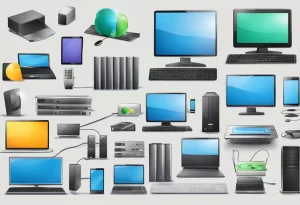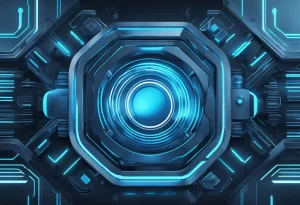Expert Overview: What You Need to Know About Information Technology
What is Information Technology - See Expert Info

Information technology (IT) is a broad term that encompasses various fields related to computer hardware, software, networking, and other digital systems. IT is an essential part of modern society, and it plays a critical role in many aspects of our daily lives. From communication to entertainment, education to healthcare, IT has revolutionized the way we live and work.
The definition of information technology can vary depending on the context. In general, IT refers to the use of technology to create, process, store, secure, and exchange all forms of electronic data. Typically, IT is used in the context of business operations, as opposed to technology used for personal or entertainment purposes. It is a constantly evolving field, and new technologies are being developed every day to improve efficiency, productivity, and innovation.
Key Takeaways
- Information technology encompasses various fields related to computer hardware, software, networking, and other digital systems.
- IT is an essential part of modern society and plays a critical role in many aspects of our daily lives.
- IT is a constantly evolving field, and new technologies are being developed every day to improve efficiency, productivity, and innovation.
Definition of What is Information Technology Information Technology
Information Technology (IT) is a term used to describe the use of computers, software, and other digital devices to process, store, and transmit data. It involves the use of technology to manage and process information, and to support business operations. IT is a broad field that encompasses a range of technologies, including hardware, software, networking, and data management.
Components of IT
IT is made up of several components, including hardware, software, and networking. Hardware refers to the physical components of a computer system, such as the central processing unit (CPU), memory, and storage devices. Software refers to the programs and applications that run on the hardware, such as operating systems, word processors, and games. Networking refers to the connections between computers and other devices, such as routers and servers, that allow them to communicate with each other.
Role of IT
IT plays a critical role in modern business operations. It allows companies to process and store large amounts of data, automate routine tasks, and communicate with customers and suppliers. IT also enables companies to analyze data and make informed decisions based on that analysis. In addition, IT is essential for maintaining the security of digital information and protecting against cyber threats.
In summary, IT is the use of digital technology to process, store, and transmit information. It is made up of several components, including hardware, software, and networking, and plays a critical role in modern business operations.
Historical Overview of Information Technology
Information technology (IT) has evolved from ancient communication methods like cave drawings to modern innovations like the internet. The telegraph in the mid-19th century revolutionized long-distance communication, leading to the development of the telephone and radio. By the mid-20th century, computers emerged, initially as large and expensive machines, but became more accessible with the introduction of microprocessors in the 1970s. The rise of the internet in the 1990s transformed IT, enabling global communication and the growth of e-commerce and social media. Today, IT is essential in our lives, driving advancements in smartphones, cloud computing, and artificial intelligence.
Information Technology Infrastructure
Information technology infrastructure refers to the collection of hardware, software, and networks that are required for the operation and management of enterprise IT services and IT environments. The infrastructure is designed to support the delivery of IT services to different business units and help maintain their digital presence.
Hardware
Hardware refers to the physical components of the IT infrastructure. It includes devices such as servers, desktops, laptops, mobile devices, and storage devices. These devices are used to store, process, and transmit data across the network. The hardware components are selected based on the specific requirements of the organization and the IT environment.
Software
Software refers to the programs, applications, and operating systems that are used to manage the IT infrastructure. It includes software for managing databases, servers, network devices, and security systems. The software components are selected based on the specific requirements of the organization and the IT environment.
Networks
Networks refer to the communication pathways that allow devices to connect and communicate with each other. It includes wired and wireless networks, routers, switches, and firewalls. Networks are essential for transmitting data across the organization and providing access to IT services.
In summary, information technology infrastructure is a critical component of any organization’s IT strategy. The hardware, software, and networks that make up the infrastructure are designed to support the delivery of IT services and maintain the organization’s digital presence. Organizations must carefully select the components of the infrastructure to ensure that they meet the specific requirements of the organization and the IT environment.
Types of Information Technology

Information technology (IT) is a vast field that encompasses a wide range of technologies and services. Here are some of the most common types of IT:
Enterprise IT
Enterprise IT refers to the technology and services that businesses use to manage their operations and data. This includes software applications, hardware infrastructure, and networking technologies. Enterprise IT is critical to the success of businesses of all sizes, from small startups to large multinational corporations.
AI and Machine Learning
Artificial intelligence (AI) and machine learning (ML) are technologies that enable computers to learn and make decisions like humans. AI and ML are used in a variety of applications, from image recognition and natural language processing to fraud detection and predictive maintenance. These technologies are becoming increasingly important in many industries, including healthcare, finance, and manufacturing.
Cloud Computing
Cloud computing is a technology that allows users to access computing resources over the internet, rather than having to maintain their own hardware and software. Cloud computing can be used for a wide range of applications, from hosting websites and web applications to running complex data analytics. Cloud computing is also becoming increasingly popular for storing and sharing data, as it provides a cost-effective and scalable solution.
Cybersecurity
Cybersecurity is the practice of protecting computer systems and networks from unauthorized access, theft, and damage. Cybersecurity is critical to the success of businesses and organizations of all sizes, as cyber attacks can cause significant financial and reputational damage. Cybersecurity technologies and services include firewalls, antivirus software, intrusion detection and prevention systems, and security information and event management (SIEM) systems.
Overall, information technology is a critical component of modern business and society. By leveraging the latest technologies and services, businesses and organizations can improve their operations, enhance their competitiveness, and better serve their customers and stakeholders.
Impact of Information Technology

Information technology (IT) has had a significant impact on various aspects of society, including the economy, social interactions, and the environment.
Economic Impact
The economic impact of IT is vast. IT has transformed the way businesses operate, from manufacturing to finance. It has enabled companies to streamline their operations, reduce costs, and increase productivity. IT has also created new industries, such as e-commerce, online advertising, and cloud computing. The growth of these industries has led to the creation of new jobs and has contributed to economic growth.
Social Impact
IT has also had a significant impact on social interactions. The rise of social media and instant messaging has changed the way people communicate with each other. It has made communication faster and more convenient, but it has also changed the way people interact with each other. Some people argue that social media has led to a decrease in face-to-face interactions and has made people more isolated. However, others argue that social media has enabled people to connect with others who share similar interests and has helped to build communities.
Environmental Impact
IT has also had an impact on the environment. On one hand, IT has enabled companies to reduce their carbon footprint by allowing employees to work from home and reducing the need for travel. On the other hand, the production and disposal of electronic devices have contributed to electronic waste. Electronic waste is a significant environmental problem, as it contains hazardous materials that can harm the environment and human health.
Overall, IT has had a significant impact on various aspects of society. While it has brought many benefits, it has also created new challenges that need to be addressed.
Future Trends in Information Technology

As technology continues to evolve, the future of information technology (IT) looks promising. Here are some of the trends that are expected to shape the future of IT:
Artificial Intelligence (AI)
Artificial Intelligence (AI) is one of the most significant trends in IT. AI is the ability of machines to perform tasks that would typically require human intelligence. AI has already made significant inroads in areas such as healthcare, finance, and transportation. In the future, AI is expected to revolutionize the way we work and live.
Internet of Things (IoT)
The Internet of Things (IoT) is another trend that is expected to shape the future of IT. IoT refers to the interconnectivity of devices through the internet. IoT has already made significant inroads in areas such as smart homes, transportation, and healthcare. In the future, IoT is expected to revolutionize the way we live and work, making our lives more comfortable and efficient.
Cloud Computing
Cloud computing is another trend that is expected to shape the future of IT. Cloud computing refers to the delivery of computing services, including servers, storage, databases, networking, software, analytics, and intelligence, over the internet. Cloud computing has already made significant inroads in areas such as business, healthcare, and education. In the future, cloud computing is expected to become more accessible and affordable, making it easier for businesses of all sizes to take advantage of its benefits.
Cybersecurity
Cybersecurity is another trend that is expected to shape the future of IT. With the increasing reliance on technology, cybersecurity has become a critical concern for businesses and individuals alike. In the future, cybersecurity is expected to become even more critical as the number of cyber threats continues to increase.
Quantum Computing
Quantum computing is another trend that is expected to shape the future of IT. Quantum computing refers to the use of quantum-mechanical phenomena to perform calculations. Quantum computing has the potential to revolutionize the way we process and analyze data, making it possible to solve complex problems that are currently beyond the reach of traditional computing.
Overall, the future of information technology looks bright, with new and exciting trends expected to shape the way we live and work.
Conclusion
In conclusion, information technology is a broad and diverse field that involves the use of technology to communicate, transfer data, and process information. It includes various trends such as analytics, automation, artificial intelligence, cloud computing, and communications.
The field of artificial intelligence has made remarkable progress in the past few years and is having a real-world impact on people, institutions, and culture. The ability of computer programs to perform sophisticated language and image processing tasks has driven the field since its birth in the 1950s.
Information technology professionals have a wide range of responsibilities, including resetting account passwords and installing new printers, but their roles extend beyond that. They need to understand and track technological, economic, and societal trends and develop strategies to inform, prepare for, and respond to changes in the labor market.
Overall, information technology is a growing field that offers many opportunities for professionals to contribute to the development of new technologies and solutions. As technology continues to evolve, the demand for skilled IT professionals will continue to grow, making it an exciting and rewarding career path.
Frequently Asked Questions
What are some examples of information technology devices?
Information technology devices include computers, laptops, smartphones, tablets, servers, storage devices, networking equipment, and other hardware and software used to process, store, and transmit data.
What are the benefits of information technology?
Information technology has many benefits, including increased efficiency, productivity, and accuracy in data processing and communication. It also allows for remote work, collaboration, and access to information from anywhere in the world. Information technology can also improve decision-making through data analysis and visualization.
What are the subjects covered in information technology?
Information technology covers a wide range of subjects, including computer hardware and software, networking, database management, cybersecurity, artificial intelligence, cloud computing, and web development.
What is the job description of an information technology professional?
Information technology professionals are responsible for designing, implementing, and maintaining information systems and technology infrastructure. They may work in areas such as software development, network administration, cybersecurity, database management, and technical support.
What are the 10 features of information technology?
The 10 features of information technology include automation, accuracy, speed, reliability, scalability, security, accessibility, flexibility, interactivity, and user-friendliness.
In your own words, how would you define information technology?
Information technology is the use of hardware, software, and networking technologies to process, store, and transmit data and information. It encompasses a wide range of fields and applications, from basic computer use to advanced technologies such as artificial intelligence and cloud computing.

I am a technology Specialized writer and blogger based in the USA & UK. I have four years of experience in Cyber Security, Technology, Social Media and all types of electronic devices like computer laptops etc. So I work on solving these issues and give various tips on these issues



